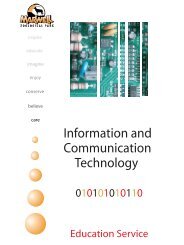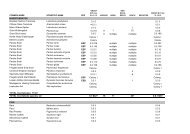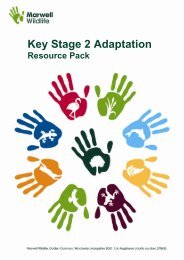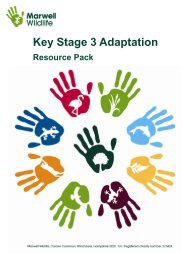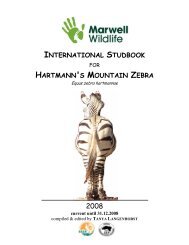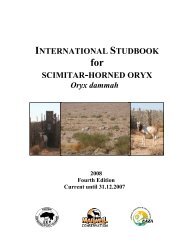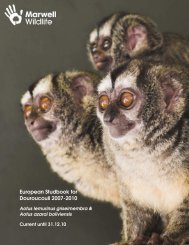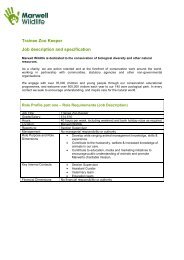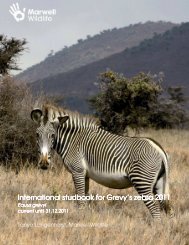Create successful ePaper yourself
Turn your PDF publications into a flip-book with our unique Google optimized e-Paper software.
<strong>KS1</strong><br />
<strong>Baby</strong><br />
<strong>Animals</strong><br />
<strong>Marwell</strong> <strong>Wildlife</strong><br />
Colden Common<br />
Winchester<br />
Hampshire SO21 1JH<br />
<strong>Marwell</strong> is a limited liability company registered in England and Wales under no. 1355272. The company is a registered charity, no. 275433. VAT no. 631<br />
9661 30. Registered office: <strong>Marwell</strong> <strong>Wildlife</strong>, Colden Common, Winchester, Hampshire SO21 1JH.
Contents<br />
Teachers’ Notes 2<br />
Chick Story. 1 – (easier) 4<br />
Chick Story. 2 – (harder) 5<br />
Birds’ Nests 6<br />
Bird Life Cycles 7<br />
Not Only Birds Lay Eggs. 8<br />
Meet and Make Wendy Wallaby. 9, 11 & 13<br />
How Grown-up are the Babies? 15<br />
Which <strong>Baby</strong> <strong>Animals</strong> can you see<br />
at <strong>Marwell</strong> <strong>Wildlife</strong>? 16<br />
Tick List 17<br />
Appendix : Hammerkop nest picture 18<br />
Wallaby information 19<br />
Evaluation Form 20<br />
1
Curriculum Links<br />
Teachers’ Notes<br />
Learning objective: Learning outcomes:<br />
To understand that humans and<br />
other animals can produce offspring<br />
and that these offspring grow into<br />
adults<br />
Curriculum links:<br />
Sc2.2f<br />
Children should know that humans<br />
and other animals can produce<br />
offspring and that these offspring<br />
grow into adults<br />
Notes on Activities<br />
All children:<br />
• Can recognise that some<br />
animals are babies.<br />
• Know that some animals<br />
lay eggs, and can give<br />
examples.<br />
• Can describe stages in a<br />
bird life cycle.<br />
Some children:<br />
• Can explain how some<br />
parent animals care for their<br />
babies.<br />
Chick Story – An activity for school<br />
This activity is to order the pictures and/or the sentences correctly to describe the family life of<br />
birds. There are two levels of the activity – the first is easier as the words are already in order.<br />
In Chick Story 1, you could cut out the pictures to sort them out, and in Chick Story 2 you<br />
could cut out the sentence strips and stick them down in the right order. You could also use<br />
the pictures from Chick Story 1 with the sentences from Chick Story 2.<br />
Birds’ Nests – An activity for <strong>Marwell</strong> and back at school<br />
If doing this with younger children, you can talk through the questions, and ask them to draw<br />
the nest on a larger sheet of paper. If you are doing this activity in school or do not see the<br />
hammerkops at <strong>Marwell</strong>, use the hammerkop nest picture in the Appendix (page 15).<br />
They could build their own nest models using small sticks, straw, some short lengths of wool,<br />
string, or raffia and some moss or leaves for lining.<br />
Bird Life Cycles – An activity for school or <strong>Marwell</strong><br />
Fill in the missing words and draw the missing pictures to finish the life cycles of the penguin<br />
and the crane.<br />
2
Teachers’ Notes<br />
Not Only Birds Lay Eggs – An activity for school<br />
Most reptiles, nearly all amphibians and fish, and many invertebrates lay eggs, as well as<br />
birds. This page has some photos of some animals with their eggs, to illustrate the diversity<br />
of animals which lay eggs. The activity is to match the words with the pictures. It could lead<br />
to discussion or research on other examples of egg-layers, whether the parents look after the<br />
eggs or leave them to hatch (compare crocodiles’ parental care with turtles “buries and<br />
leaves” behaviour with their eggs). Or look at the quantities of eggs laid: animals which do not<br />
take care of their offspring, such as fishes and frogs, will lay a large number of eggs. <strong>Animals</strong><br />
which take care of their offspring, such as birds, or whose eggs or chicks are less likely to be<br />
predated, will produce fewer eggs. eg: cod: 5 million, frog: 1500, grass snake: 40, robin: 3-5,<br />
penguin: 1.<br />
Wendy Wallaby – An activity for school or at home<br />
Colour the pieces with soft crayons or wax crayons, using short strokes to get a furry texture.<br />
Leave the insides of the ears white and the Wendy’s tummy paler brown than her back.<br />
When she and her pouch are made, you can play with Wendy, put her into the pouch, use<br />
her like a finger puppet, or make up stories for her.<br />
You can change her name too, if you want to! Maybe yours is a Walter, or a Warren, or a<br />
Willow…<br />
How Grown-up are the Babies? – An activity for school, link with <strong>Marwell</strong> observations.<br />
Giraffes and zebras, and the other hoofed animals, are born almost ready to run! They look<br />
very like their parents in shape and patterns – just smaller. They can stand up after 20<br />
minutes to an hour, and then very quickly are able to run. All their senses are developed at<br />
birth too. They need this to be able to escape from being eaten by predators, such as lions.<br />
The mum will feed them milk and look after them for up to18 months for a giraffe, but they look<br />
and behave in many ways like mini-adults from birth.<br />
Compare this with helpless human babies, or the black-cheeked lovebirds (and many other<br />
birds) born without feathers! The humans and the lovebirds are much less developed when<br />
they are born, and need full care from parents for quite some time, feeding, cleaning, teaching<br />
and protection.<br />
The activity is a simple matching one, but could be extended into finding out about more<br />
animals which are un-developed at birth, and which ones are well-developed, and finding out<br />
how long they take to grow up. You may find some useful information on the Animal<br />
Encyclopaedia on the Park Guide section of the <strong>Marwell</strong> <strong>Wildlife</strong> website<br />
(www.marwell.org.uk).<br />
Which Babies <strong>Animals</strong> Can You See? – An activity for during a visit to <strong>Marwell</strong><br />
Make several copies of the Tick List (page 14) for the children to fill in – you will probably see<br />
enough babies (or at least young animals) for 2 pages or more.<br />
When the children see a baby animal, they:<br />
• write the name in the left hand column,<br />
• draw a little picture of the baby animal in the middle column if there is time<br />
• write down what it was doing<br />
• put a big tick in the right hand column<br />
3
Chick Story 1<br />
Birds have babies called chicks.<br />
The pictures are in the wrong order.<br />
Join them to the right words with a line.<br />
1. The birds build a nest.<br />
2. The mother bird lays<br />
eggs in the nest.<br />
3. Parents sit on the eggs<br />
to keep them warm.<br />
4. The eggs break open<br />
and chicks come out.<br />
5. Parents feed the<br />
chicks.<br />
4
Chick Story 2<br />
Birds have babies called chicks.<br />
Sort the sentences below into the right order, to tell the story.<br />
� Parent birds build a nest.<br />
� Parents sit on the eggs to keep them warm.<br />
� Mother bird lays eggs in the nest.<br />
� Chicks learn to find their own food.<br />
� Often the chicks learn to fly.<br />
� Parents usually feed the chicks at first.<br />
� Chicks hatch out of the eggs.<br />
5
Birds’ Nests<br />
Look at the enclosure of the hammerkop. Then think about,<br />
talk about and/or write about the questions below.<br />
• Can you spot the nest which the birds have built in the tree? Draw a<br />
picture of it in the box below, or on spare paper.<br />
• Are the birds sitting in the nest? _________________________________<br />
• What is the nest made of? ______________________________________<br />
• Why do you think they have built the nests up in the trees, not on the<br />
ground?<br />
_______________________________________________________________<br />
• Some birds have nests on the ground, like the Magellan goose<br />
below, so how could they try to keep them safe?<br />
_________________________________________________________<br />
_________________________________________________________<br />
Hammerkop nest<br />
Magellan<br />
goose nest<br />
6
Bird Life Cycles<br />
Fill in the words and pictures below, using words<br />
from the central box where you need them.<br />
egg<br />
_ _ _ _ _<br />
_ _ _ _ _ _ _ _ _<br />
egg<br />
chick<br />
adult bird<br />
chick<br />
_ _ _ _ _ _ _ _ _<br />
penguin crane<br />
7
Not Only Birds Lay<br />
Eggs!<br />
Join the word boxes to the right pictures.<br />
Gecko<br />
A tokay gecko (a lizard) is<br />
looking after its eggs.<br />
Snake<br />
A baby snake is hatching<br />
from its egg.<br />
Ostrich<br />
A mother ostrich is<br />
looking after her eggs.<br />
Frog<br />
A frog is with its frogspawn (eggs).<br />
Can you think of any other animals which lay<br />
eggs? Draw one in the empty box above.<br />
8
Wendy is a wallaby “joey” – a baby wallaby.<br />
A wallaby is like a small kangaroo, and they<br />
live in Australia. The joeys live in their mothers’<br />
pouches for several months while they grow.<br />
You can colour and make the pouch and the<br />
joey to go in it, using this page and the next 2<br />
pages, with crayons, scissors and glue.<br />
Meet and Make<br />
…Wendy Wallaby<br />
How to make the pouch:<br />
• Colour the pouch below, with furry brown marks<br />
• Cut it out along the thick black lines; fold the dotted lines<br />
(upwards)<br />
• Colour the body page all over, except where the pouch is going.<br />
• Put some glue on the back of the tabs on pouch and stick onto<br />
the body where shown, curving the paper to fit.<br />
9
Pouch<br />
goes over<br />
here<br />
11
How to make Wendy:<br />
tab<br />
• Colour the head and body on<br />
this page<br />
• Cut out round the thick black<br />
lines<br />
• Put glue on the tabs up to the<br />
dotted lines<br />
• Fold the head round in a<br />
cone shape and stick<br />
together<br />
• Fold the ears up<br />
• Fold the nose down<br />
• Fold the neck tab forward into<br />
the lower back of head<br />
tab<br />
13
How “Grown-up”<br />
are the Babies?<br />
Some newborn babies need more help than others. There is a<br />
baby picture and an adult picture of three species of animals on<br />
this page. Match the baby with its parent.<br />
Which baby below do you think is ready to run away an hour<br />
after birth?<br />
human<br />
black-cheeked lovebird<br />
giraffe<br />
15
Which Babies Can You See at<br />
<strong>Marwell</strong> <strong>Wildlife</strong>?<br />
These are some baby animals which you might see:<br />
You are most<br />
likely to see<br />
these:<br />
a. giraffe<br />
b. zebra<br />
c. gazelle<br />
d. antelope<br />
e. meerkat<br />
f. capybara<br />
g. wallaby<br />
You might see<br />
these:<br />
1. duck<br />
2. leopard<br />
3. coati<br />
4. tamarin<br />
5. lemur<br />
6. penguin<br />
1<br />
4<br />
e<br />
b<br />
c<br />
2<br />
5<br />
f<br />
3<br />
d<br />
6<br />
a<br />
g<br />
16
Animal Picture<br />
Which babies have<br />
you seen?<br />
What is the baby<br />
doing? Feeding,<br />
with parents,<br />
playing, or in a nest? Tick<br />
17
Hammerkop<br />
Appendix<br />
Hammerkop Nest<br />
Yes – this pile of hay up a tree is a nest! You<br />
can see a hole in the side, which is an<br />
entrance to an inner chamber where the<br />
eggs will be laid. The birds build a new<br />
chamber each year.<br />
It measures about 1.5 m across and has built<br />
up over the years since 2005, although<br />
sometimes older bits collapse after bad<br />
weather. The keepers make sure there is<br />
enough hay, twigs, mud and droppings<br />
(normally from the rhinos!) available, to help<br />
the birds build it.<br />
18
Appendix<br />
Wallabies<br />
Wallaby Background Information<br />
Photos: <strong>Marwell</strong> <strong>Wildlife</strong><br />
When a wallaby is born it is very little developed, blind and is<br />
about the size of one baked bean! It has a sense of smell,<br />
crawls up to its mother’s pouch and, once inside, clasps onto<br />
a nipple to feed. The “joey” stays in the pouch for six to nine<br />
months. During the last 3 months, it will get in and out of the<br />
pouch, hopping back in quickly if scared by anything!<br />
Wallaby Book: “There's an Ouch in My Pouch!” by Jeanne<br />
Willis is about the arrival of a new sibling in the family, and also<br />
accurate in its wallaby science.<br />
This baked bean is about 12 mm long – about the size of a<br />
wallaby “pouch embryo” when it is born.<br />
19
<strong>Marwell</strong> Resource Evaluation Form<br />
Resource: <strong>KS1</strong> <strong>Baby</strong> <strong>Animals</strong> Date used:<br />
School: Your name:<br />
1. Which parts of the resource did you use?<br />
Chick Story 1<br />
Chick Story 2<br />
Birds' Nests<br />
Bird Life Cycles<br />
Not Only Birds Lay Eggs<br />
Wendy Wallaby<br />
How Grown-up are the Babies?<br />
Which <strong>Baby</strong> <strong>Animals</strong> Can You See?<br />
Tick List<br />
2. Did your students learn anything by carrying out the activities?<br />
Yes No<br />
3.How enjoyable did your pupils find the resource?<br />
Not at all enjoyable Quite enjoyable Enjoyable Very enjoyable<br />
4. Please rank (1 is highest) your top three reasons for choosing to do this resource:<br />
Fits in with the topic we are doing<br />
Looked fun<br />
It is educational<br />
To keep children focused in the park Please specify "Other":<br />
Good curriculum links<br />
Added value for money<br />
To meet ‘Learning outside the classroom” objectives<br />
Other<br />
5. How easy to understand were the teacher guidelines for the activities?<br />
Difficult OK Very clear<br />
6. How easy did you find it to carry out the activities in the Park?<br />
Difficult OK Very easy<br />
7. If you have any comments to improve the resource, write them here:<br />
Please return to: Science & Learning Centre, <strong>Marwell</strong> <strong>Wildlife</strong>, Colden Common, Hants, SO21 1JH<br />
20




